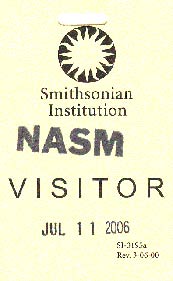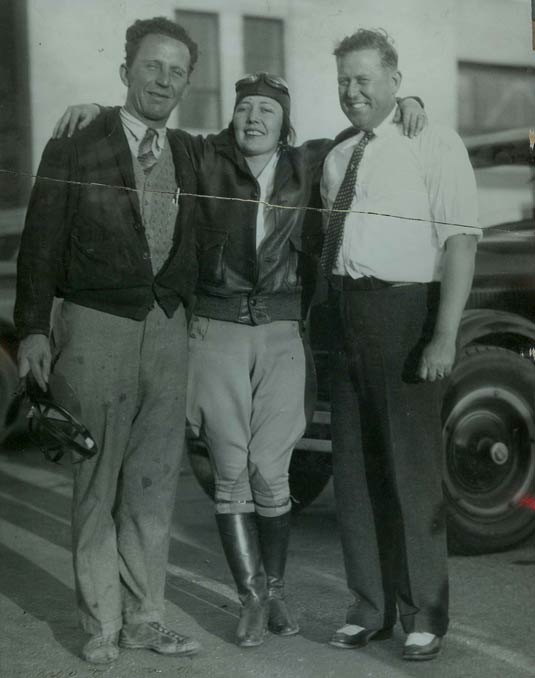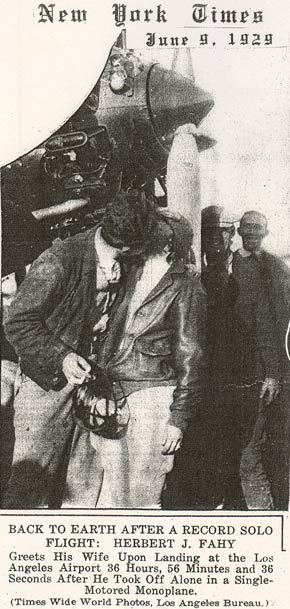|
HERBERT J. “HUB” FAHY
Lockheed Test Pilot
Herbert “Hub” Fahy was a test pilot for Lockheed
Aircraft in Burbank,
CA. His wife, Claire, was also
a pilot and air racer. Both flew airplanes to the Davis-Monthan
Airfield and signed the Register. The wonderful
image below is from the Hudgin Family Collection, shared
with us by Louis Hudgin, nephew of Al
Hudgin, one of our
Register pilots. Hub is on the left, then Claire. Unknown
gentleman on the right. The photograph is signed at bottom left, "Regards to you, Ed. Hub Fahy." It could be the gentleman's name, Ed. The interesting item in Fahy's right hand is a sun visor, which consists of a visor that he holds between his fingers, and an open framework that slips over the head. It was a ball cap without the cap.
Mr. Fahy landed six times between May 6, 1929 and March
3, 1930. Not surprisingly, five of his landings were
in Lockheed aircraft (three different Vegas, NC194E,
NC536M, NC868E,
and twice in Sirius NC349V). Interestingly,
Claire was one of his passengers on all these visits.
Below, courtesy of Tim Kalina, is an image of Fahy and his wife in front of an unidentified Lockheed Vega. This photograph was taken March 6, 1930, three days after their last landing at Tucson.
Claire and Hub Fahy, March 6, 1930
(Source: Kalina)
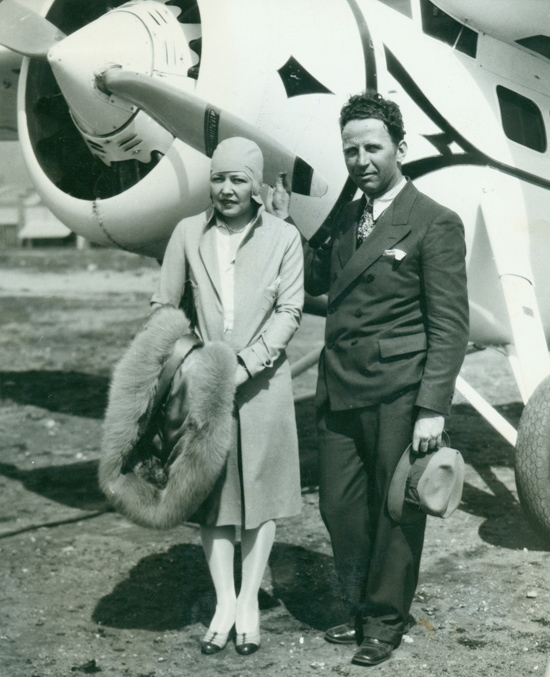 |
Below, the caption on the back of the photograph.
Claire and Hub Fahy, March 6, 1930, Caption
(Source: Kalina)
 |
Washington Post, June 3, 1922
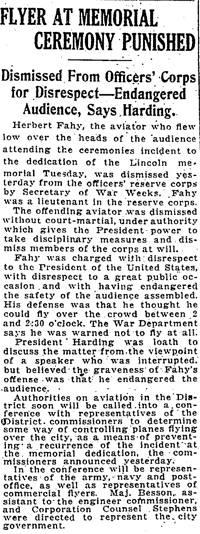 |
New York Times, May 22, 1922
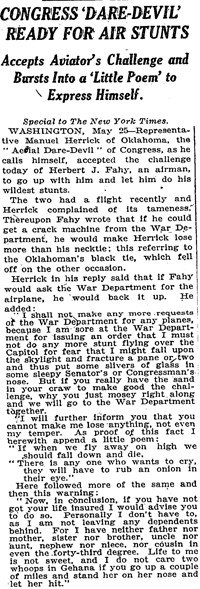 |
Pilot Fahy had earlier military experience, and earned the
rank of lieutenant. He had a jocular relationship with at least one member of Congress, as cited in the article at left.
Unfortunately, he had a well-intentioned, but tarnished, experience in the military. He was a lieutenant in the reserve when, in 1922, he made a low pass over a crowd in Washington, DC and was summarily dismissed from the service. The article at right from the Washington Post, June 3, 1922 provides details. This flight couldn't have been more public, or in front of less sympathetic people.
He flew low over the solemn memorial ceremonies held during the dedication of the Lincoln Memorial by President Harding. Harding was not amused and used his Executive powers to see that Fahy was summarily stripped of his commission and dismissed from the military.
The example of Fahy's flight was taken to law makers who developed early rules governing aircraft flying over crowds or populated areas. The local news stated, "...the wheels of legislation set in motion to draw up and adopt a set of laws regulating air traffic over the city." These basic rules live in the Federal Aviation Regulations of today.
The spring and summer of 1922 were not good for Fahy. The Washington Post of July 26th reported an accident involving Fahy and passenger Lewis Swan, who was killed. Fahy, Swan and another colleague had just, "...finished overhauling" the plane, and it was up for a test flight. Fahy was pilot; Swan the passenger. The airplane was in the air five minutes before it crashed from low altitude. Fahy was severely injured. No cause was specified for the accident.
Today, after maintenance, good mechanic's practice suggests that an airplane be taken aloft solo by a qualified pilot who evaluates the systems on which work was performed. Only after thorough testing, and the OK from the pilot, are passengers taken up.
While Chief Pilot for Lockheed,
after two sequential attempts in late May 1929, he broke
the world’s record for non-refueled endurance when
he flew a Lockheed Vega from LA
Metropolitan Airport and
remained aloft for 36 hours, 56 minutes and 36 seconds.
His first attempt departed on May 26th. As well as
435 gallons of gasoline, the New York Times of May 26, 1929 states, “Plenty
of sandwiches and coffee were taken. Also one rabbit’s
foot went along. It was the same good-luck charm used
on the army plane Question Mark when it broke the world’s
endurance record for all aircraft.” This attempt
was terminated by fog after a little more than 21 hours aloft.
Finally, on May 30th, circling the field at 1,500 feet,
he set his new record. The times he beat were previously
set by Charles Lindbergh in May 1927 (about 33.5 hours),
Royal V. Thomas at Roosevelt Field, NY on May 3, 1928 (35:24:59),
and by Martin Jensen at Roosevelt Field on February 6, 1929
(35:33:21). The image, right, from the New York Times
of June 9, 1929 shows Fahy and wife Claire at the end of
his flight.
---o0o---
Barely a month later, Fahy was set to challenge the coast-to-coast
record set by Frank Hawks of Los Angeles. Hawks held
the one-way LA-NY record of 17:36:16, the NY-LS record of
19:10:32, and the round trip record of 36:38:48 (these numbers
don’t exactly add up, but are cited in the Newark,
NJ Sunday Call of July 14, 1929).
The airplane he chose was the P&W Hornet-powered Lockheed
Air Express named the “Black Hornet”. According
to the New York Times of July 15, 1929 (image below), he
departed Los Angeles at 12:06:52AM on July 14th and flew
for the next 6.5 hours. He
developed oil system problems over Kansas and the sides of
the airplane were covered with oil. Although the engine
was running well, he made a precautionary landing at Kiowa,
KS at 8:45AM (Central Time). He had traveled approximately
half-way on the great circle route from Los Angeles to New
York. The story is also covered in the Los Angeles Times of July 15th.
He checked his airplane carefully, took on 15 gallons of
oil, offloaded 200 gallons of fuel, and flew the Lockheed
to Wichita, KS for repairs, arriving at 3:30PM. Although
his company and backers wanted him to continue the flight
from Wichita, Fahy decided to return to Los Angeles to try
another day. He did not, and the “Black Hornet” (not
cited in the Davis-Monthan Airfield Register) was sold, eventually
becoming noteworthy as flown by Roscoe Turner.
---o0o---
Unfortunately, after Fahy’s last visit to Tucson on
March 3, 1930, he had only 55 more days to live. This
is the story of how he died.
In late April 1930, he
and Claire flew a new Sirius (NC12W, a Model 8, not a Register airplane) to a small grass strip in Roscommon,
MI, where they were to demonstrate the plane to a potential
buyer, Cliff Durant, son of William Durant, founder of General
Motors. Cliff was a wealthy aviation enthusiast who
had owned a number of airplanes since 1919 when he started
a flying service and built Durant Field in Oakland, CA.
The Fahys acted as sales agents for Lockheed and the deal
was Durant agreed to buy the plane if Fahy could prove that
the Sirius could land and takeoff safely from Durant’s
personal strip. Herb and Claire got the plane on the
ground without incident, but as they took off, one of the
wheels of the Sirius hit a partially hidden stump, which
flipped the plane over.
According to reports in the Herald Tribune for April 26
and 28, 1930, Fahy suffered a fractured skull and a severe
concussion while Claire survived uninjured. Rescuers
had to cut away part of the plane's structure to extricate
the fliers. Fahy was rushed to a local hospital where
he died early on Sunday morning, April 27, 1930 without regaining
consciousness. The Washington Post of April 26 & 28, 1930 also reports the accident and Fahy's death therefrom. He was 33 years old.
---o0o---
Dossier 2.1.85
UPLOADED: 07/19/06 REVISED:
|

